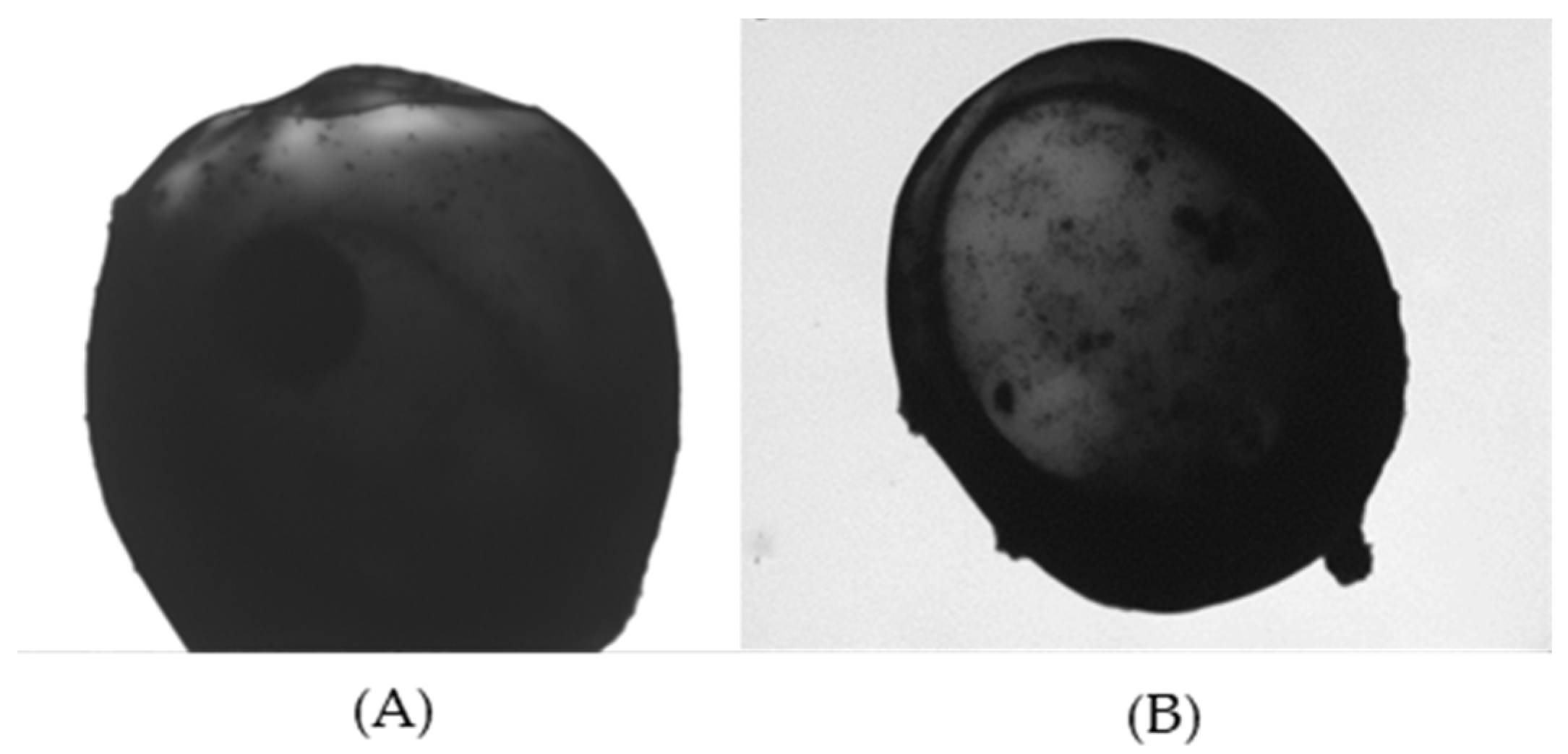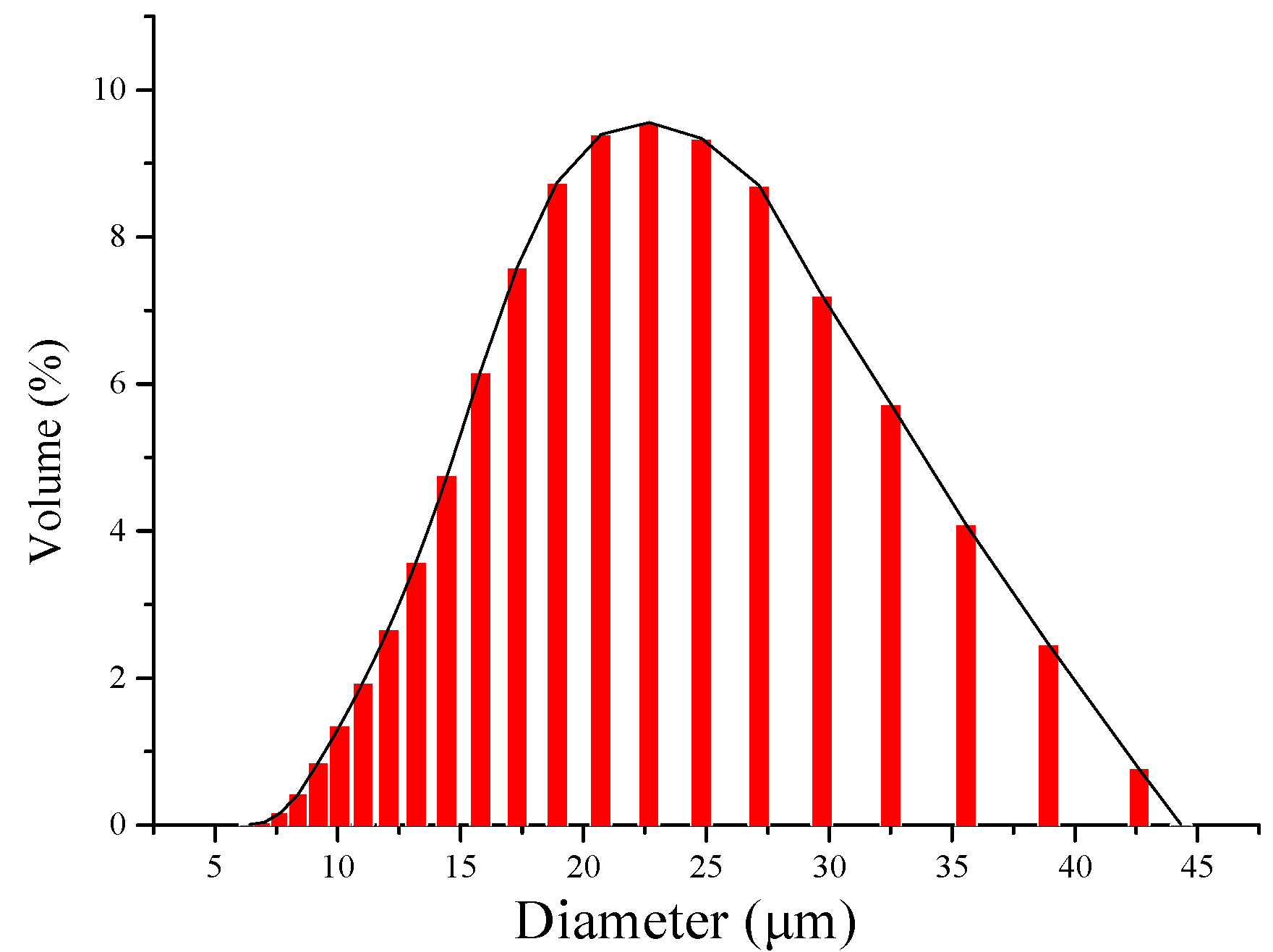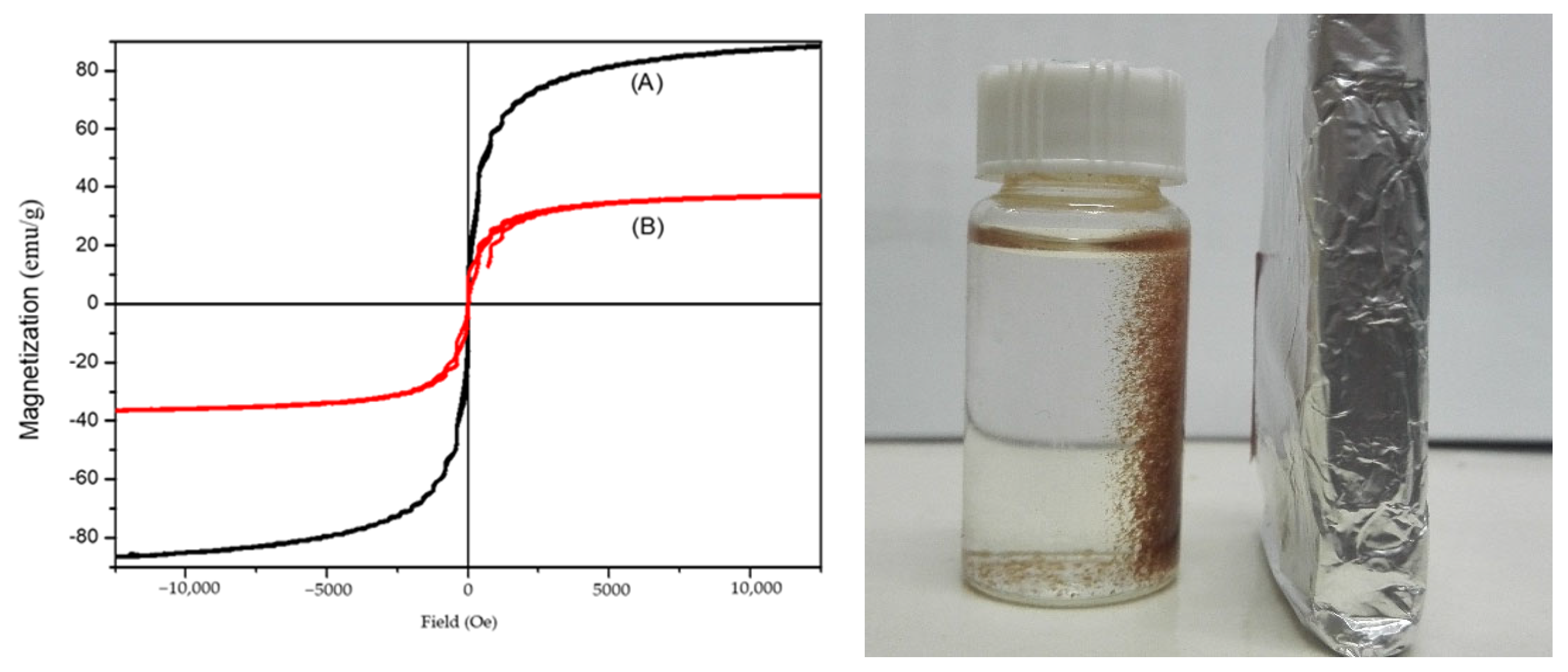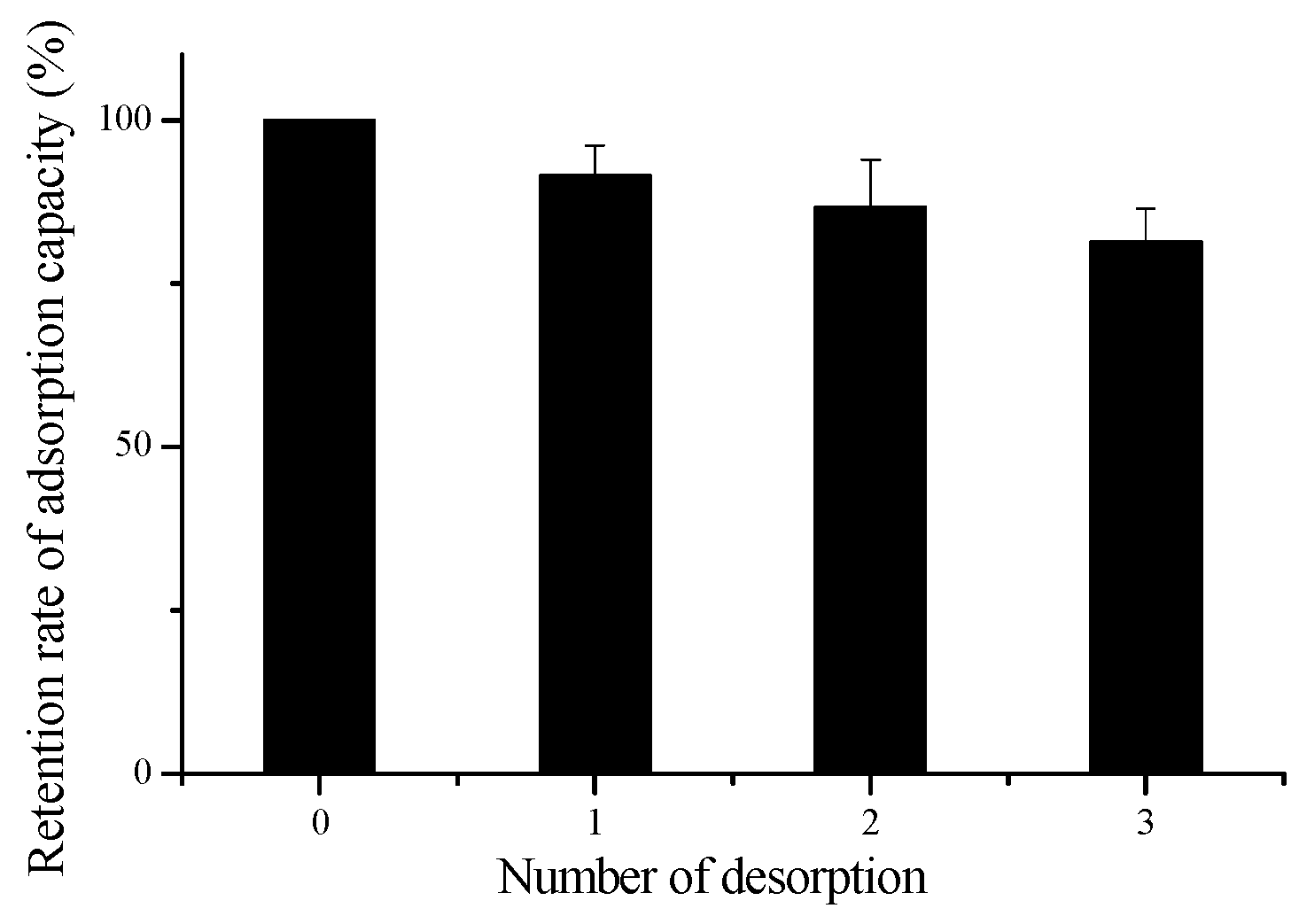Preparation of Magnetic Hemicellulosic Composite Microspheres and Adsorption of Copper Ions
Abstract
1. Introduction
2. Materials and Methods
2.1. Reagents
2.2. Preparation of Hemicellulose/Fe3O4 Magnetic Composite Microspheres
2.2.1. Synthesis of Fe3O4 Nanoparticles
2.2.2. Synthesis of Ionic Liquid 1-Butyl-3-Methylimidazolium Chloride (B[mim]Cl)
2.2.3. Preparation of Composite Microspheres
2.3. Characterization Methods
2.4. Adsorption Experiments
2.4.1. Determination of Adsorption Capacity of the Microspheres for Copper Ions
2.4.2. Effect of pH on the Adsorption Amount
2.4.3. Effect of Initial Cu2+Concentration on the Adsorption Amount
2.4.4. Effect of Adsorption Time on the Adsorption Amount
2.4.5. Reusability of the Microspheres
3. Results and Discussion
3.1. TEM Analysis of Fe3O4 Nanoparticles
3.2. Characterization of the Microsphere
3.2.1. Relationship Between Particle Size of Microspheres and Preparation Progress Parameters
3.2.2. Analysis of FT-IR Spectrum
3.2.3. SEM and TEM Analysis
3.2.4. Analysis of Granularity
3.2.5. Analysis of VSM Results
3.3. Adsorption Study of Copper Ions by the Microspheres
3.3.1. Effect of pH on the Adsorption Property of the Microspheres
3.3.2. Effect of Initial Cu2+ Concentration on the Adsorption Property of the Microspheres
3.3.3. Effect of Adsorption Time on the Adsorption Capacity of the Microspheres
3.4. Adsorption Kinetics of the Microspheres
3.5. Adsorption Thermodynamics of the Microspheres
3.6. Reusability Performance of the Microspheres
4. Conclusions
Supplementary Materials
Author Contributions
Funding
Institutional Review Board Statement
Data Availability Statement
Conflicts of Interest
References
- Ugelstad, J.; Ellingsen, T.; Berge, A.; Helgee, O.B.; Sintef, A.S. Magnetic Polymer Particles and Process for the Preparation Thereof. U.S. Patent 4,654,267, 31 March 1987. [Google Scholar]
- Ali, N.; Zhang, B.; Zhang, H.; Li, W.; Zaman, W.; Tian, L.; Zhang, Q. Novel Janus magnetic micro particle synthesis and its applications as a demulsifier for breaking heavy crude oil and water emulsion. Fuel 2015, 141, 258–267. [Google Scholar] [CrossRef]
- Kawaguchi, H. Functional polymer microspheres. Prog. Polym. Sci. 2000, 25, 1171–1210. [Google Scholar] [CrossRef]
- Wang, X.; Liu, X.; Lei, L.; Zhu, H.; Yang, Y.; Li, Y. Preparation and characterization of magnetic microspheres with an epoxy group coating and their applications for lipase immobilization. J. Macromol. Sci. Part B 2014, 53, 1348–1363. [Google Scholar] [CrossRef]
- Sun, L.; Shi, Y.; Chu, L.; Xu, X.; Liu, J. Preparation of polyaniline coated polystyrene-poly (styrene-co-sodium 4-styrenesulfonate) microparticles and the further fabrication of hollow polyaniline microspheres. J. Appl. Polym. Sci. 2012, 126, 870–876. [Google Scholar] [CrossRef]
- Silva, M.F.; Ciciliatti, M.A.; Hechenleitner, A.A.W.; Peñalva, R.; Agüeros, M.; Irache, J.M.; Oliveira, A.J.d.; Farooqi, A.A.; Pineda, E.A. Superparamagnetic maghemite loaded poly (ε-caprolactone) nanocapsules: Characterization and synthesis optimization. Matéria 2014, 19, 40–52. [Google Scholar] [CrossRef]
- Gao, Y.; Zhang, J.; Liang, J.; Yuan, D.; Zhao, W. Research progress of poly (methyl methacrylate) microspheres: Preparation, functionalization and application. Eur. Polym. J. 2022, 175, 111379. [Google Scholar] [CrossRef]
- Tan, J.; Zhao, G.; Lu, Y.; Zeng, Z.; Winnik, M.A. Synthesis of PMMA microparticles with a narrow size distribution by photoinitiated RAFT dispersion polymerization with a macromonomer as the stabilizer. Macromolecules 2014, 47, 6856–6866. [Google Scholar] [CrossRef]
- Wang, Y.; Sun, B.; Hao, Z.; Zhang, J. Advances in organic–inorganic hybrid latex particles via in situ emulsion polymerization. Polymers 2023, 15, 2995. [Google Scholar] [CrossRef]
- Chen, L.-H.; Ban, C.; Helal, M.H.; El-Bahy, S.M.; Zeinhom, M.; Song, S.; Zhao, Y.-G.; Lu, Y. Preparation and modification of polymer microspheres, application in wastewater treatment: A review. J. Environ. Manag. 2024, 366, 121807. [Google Scholar] [CrossRef]
- Li, X.; Zhang, B.; Li, W.; Lei, X.; Fan, X.; Tian, L.; Zhang, H.; Zhang, Q. Preparation and characterization of bovine serum albumin surface-imprinted thermosensitive magnetic polymer microsphere and its application for protein recognition. Biosens. Bioelectron. 2014, 51, 261–267. [Google Scholar] [CrossRef]
- Wang, M.; Wang, X.; Yue, Q.; Zhang, Y.; Wang, C.; Chen, J.; Cai, H.; Lu, H.; Elzatahry, A.A.; Zhao, D. Templated fabrication of core–shell magnetic mesoporous carbon microspheres in 3-dimensional ordered macroporous silicas. Chem. Mater. 2014, 26, 3316–3321. [Google Scholar] [CrossRef]
- Boxall, C.; Kelsall, G.; Zhang, Z. Photoelectrophoresis of colloidal iron oxides. Part 2.—Magnetite (Fe3O4). J. Chem. Soc. Faraday Trans. 1996, 92, 791–802. [Google Scholar] [CrossRef]
- Yamaura, M.; Camilo, R.L.; Sampaio, L.C.; Macêdo, M.A.; Nakamura, M.; Toma, H.E. Preparation and characterization of (3-aminopropyl) triethoxysilane-coated magnetite nanoparticles. J. Magn. Magn. Mater. 2004, 279, 210–217. [Google Scholar] [CrossRef]
- Jafari, A.; Shayesteh, S.F.; Salouti, M.; Boustani, K. Effect of annealing temperature on magnetic phase transition in Fe3O4 nanoparticles. J. Magn. Magn. Mater. 2015, 379, 305–312. [Google Scholar] [CrossRef]
- Demir, A.; Baykal, A.; Sözeri, H. Green synthesis of Fe3O4 nanoparticles by one-pot saccharide-assisted hydrothermal method. Turk. J. Chem. 2014, 38, 825–836. [Google Scholar] [CrossRef]
- Lu, T.; Wang, J.; Yin, J.; Wang, A.; Wang, X.; Zhang, T. Surfactant effects on the microstructures of Fe3O4 nanoparticles synthesized by microemulsion method. Colloids Surf. A Physicochem. Eng. Asp. 2013, 436, 675–683. [Google Scholar] [CrossRef]
- Manikandan, A.; Vijaya, J.J.; Mary, J.A.; Kennedy, L.J.; Dinesh, A. Structural, optical and magnetic properties of Fe3O4 nanoparticles prepared by a facile microwave combustion method. J. Ind. Eng. Chem. 2014, 20, 2077–2085. [Google Scholar] [CrossRef]
- Huang, Y.-R.; Li, L.; Wei, X.-M.; Li, H.-Z.; Zeng, J.-Y.; Kuang, R. An investigation of mechanisms for the enhanced coagulation removal of Microcystis aeruginosa by low-frequency ultrasound under different ultrasound energy densities. Ultrason. Sonochemistry 2020, 69, 105278. [Google Scholar] [CrossRef]
- Zhang, X.; Wang, H.; Yang, C.; Du, D.; Lin, Y. Preparation, characterization of Fe3O4 at TiO2 magnetic nanoparticles and their application for immunoassay of biomarker of exposure to organophosphorus pesticides. Biosens. Bioelectron. 2013, 41, 669–674. [Google Scholar] [CrossRef]
- Cheng, J.; Zhou, Y.; Chen, B.; Wang, J.; Xia, G.; Jin, N.; Ding, J.; Gao, C.; Chen, G.; Miao, Y. Prevention of acute graft-versus-host disease by magnetic nanoparticles of Fe3O4 combined with cyclosporin A in murine models. Int. J. Nanomed. 2011, 6, 2183–2189. [Google Scholar] [CrossRef]
- Riahi, F.; Bagherzadeh, M.; Hadizadeh, Z. Modification of Fe3O4 superparamagnetic nanoparticles with zirconium oxide; preparation, characterization and its application toward fluoride removal. RSC Adv. 2015, 5, 72058–72068. [Google Scholar] [CrossRef]
- Li, Z.; Cao, M.; Zhang, W.; Liu, L.; Wang, J.; Ge, W.; Yuan, Y.; Yue, T.; Li, R.; William, W.Y. Affinity adsorption of lysozyme with Reactive Red 120 modified magnetic chitosan microspheres. Food Chem. 2014, 145, 749–755. [Google Scholar] [CrossRef] [PubMed]
- Zhou, S.; Wang, D.; Sun, H.; Chen, J.; Wu, S.; Na, P. Synthesis, characterization, and adsorptive properties of magnetic cellulose nanocomposites for arsenic removal. Water Air Soil Pollut. 2014, 225, 1945. [Google Scholar] [CrossRef]
- Zhou, Y.; Fu, S.; Zhang, L.; Zhan, H.; Levit, M.V. Use of carboxylated cellulose nanofibrils-filled magnetic chitosan hydrogel beads as adsorbents for Pb (II). Carbohydr. Polym. 2014, 101, 75–82. [Google Scholar] [CrossRef]
- Sud, D.; Mahajan, G.; Kaur, M. Agricultural waste material as potential adsorbent for sequestering heavy metal ions from aqueous solutions—A review. Bioresour. Technol. 2008, 99, 6017–6027. [Google Scholar] [CrossRef]
- Rissanen, J.V.; Murzin, D.Y.; Salmi, T.; Grénman, H. Aqueous extraction of hemicelluloses from spruce–from hot to warm. Bioresour. Technol. 2016, 199, 279–282. [Google Scholar] [CrossRef]
- Gallina, G.; Cabeza, Á.; Biasi, P.; García-Serna, J. Optimal conditions for hemicelluloses extraction from Eucalyptus globulus wood: Hydrothermal treatment in a semi-continuous reactor. Fuel Process. Technol. 2016, 148, 350–360. [Google Scholar] [CrossRef]
- Zhang, P.; Dong, S.-J.; Ma, H.-H.; Zhang, B.-X.; Wang, Y.-F.; Hu, X.-M. Fractionation of corn stover into cellulose, hemicellulose and lignin using a series of ionic liquids. Ind. Crop. Prod. 2015, 76, 688–696. [Google Scholar] [CrossRef]
- Minjares-Fuentes, R.; Femenia, A.; Garau, M.; Candelas-Cadillo, M.; Simal, S.; Rosselló, C. Ultrasound-assisted extraction of hemicelluloses from grape pomace using response surface methodology. Carbohydr. Polym. 2016, 138, 180–191. [Google Scholar] [CrossRef]
- Barana, D.; Salanti, A.; Orlandi, M.; Ali, D.S.; Zoia, L. Biorefinery process for the simultaneous recovery of lignin, hemicelluloses, cellulose nanocrystals and silica from rice husk and Arundo donax. Ind. Crop. Prod. 2016, 86, 31–39. [Google Scholar] [CrossRef]
- Peng, P.; She, D. Isolation, structural characterization, and potential applications of hemicelluloses from bamboo: A review. Carbohydr. Polym. 2014, 112, 701–720. [Google Scholar] [CrossRef] [PubMed]
- Wang, Y.; Yang, R.; Li, M.; Zhao, Z. Hydrothermal preparation of highly porous carbon spheres from hemp (Cannabis sativa L.) stem hemicellulose for use in energy-related applications. Ind. Crop. Prod. 2015, 65, 216–226. [Google Scholar] [CrossRef]
- Hashi, M.; Takeshita, T. Antitumor effect of 4-O-methylglucuronoxylan on solid tumor in mice. Agric. Biol. Chem. 1979, 43, 951–959. [Google Scholar] [CrossRef]
- Zhang, J.; Xiao, H.; Yang, Y. Preparation of hemicellulose-containing latex and its application as absorbent toward dyes. J. Mater. Sci. 2015, 50, 1673–1678. [Google Scholar] [CrossRef]
- Doner, L.W.; Hicks, K.B. Isolation of hemicellulose from corn fiber by alkaline hydrogen peroxide extraction. Cereal Chem. 1997, 74, 176–181. [Google Scholar] [CrossRef]
- Molday, R.; Yen, S.; Rembaum, A. Application of magnetic microspheres in labelling and separation of cells. Nature 1977, 268, 437–438. [Google Scholar] [CrossRef]
- Boom, R.; Sol, C.; Salimans, M.; Jansen, C.; Wertheim-van Dillen, P.; Van der Noordaa, J. Rapid and simple method for purification of nucleic acids. J. Clin. Microbiol. 1990, 28, 495–503. [Google Scholar] [CrossRef] [PubMed]
- Berensmeier, S. Magnetic particles for the separation and purification of nucleic acids. Appl. Microbiol. Biotechnol. 2006, 73, 495–504. [Google Scholar] [CrossRef] [PubMed]
- Sinha, V.; Trehan, A. Biodegradable microspheres for protein delivery. J. Control. Release 2003, 90, 261–280. [Google Scholar] [CrossRef]
- Kondo, A.; Fukuda, H. Preparation of thermo-sensitive magnetic hydrogel microspheres and application to enzyme immobilization. J. Ferment. Bioeng. 1997, 84, 337–341. [Google Scholar] [CrossRef]
- Trygg, J. Functional cellulose microspheres for pharmaceutical applications. Cellulose 2015, 22, 2921–2932. [Google Scholar]
- Liu, Y.; Zhang, K.; Yin, X.; Yang, W.; Zhu, H. Highly reusability surface loaded metal particles magnetic catalyst microspheres (MCM-MPs) for treatment of dye-contaminated water. J. Magn. Magn. Mater. 2016, 403, 18–29. [Google Scholar] [CrossRef]
- Zhuang, F.; Tan, R.; Shen, W.; Zhang, X.; Xu, W.; Song, W. Monodisperse magnetic hydroxyapatite/Fe3O4 microspheres for removal of lead (II) from aqueous solution. J. Alloys Compd. 2015, 637, 531–537. [Google Scholar] [CrossRef]
- Yan, H.; Cheng, X.; Sun, N. Synthesis of multi-core–shell magnetic molecularly imprinted microspheres for rapid recognition of dicofol in tea. J. Agric. Food Chem. 2013, 61, 2896–2901. [Google Scholar] [CrossRef]
- Lengyel, M.; Kállai-Szabó, N.; Antal, V.; Laki, A.J.; Antal, I. Microparticles, Microspheres, and Microcapsules for Advanced Drug Delivery. Sci. Pharm. 2019, 87, 20. [Google Scholar] [CrossRef]
- Zuo, J.; Ren, J.; Jiang, L.; Tan, C.; Li, J.; Xia, Z.; Wang, W. Preparation of PVA/SA-FMB Microspheres and Their Adsorption of Cr(VI) in Aqueous Solution. Processes 2024, 12, 443. [Google Scholar] [CrossRef]
- Wang, Z.; Wang, W.; Meng, Z.; Xue, M. Mono-Sized Anion-Exchange Magnetic Microspheres for Protein Adsorption. Int. J. Mol. Sci. 2022, 23, 4963. [Google Scholar] [CrossRef]
- Lu, C.; Puig, T.; Obradors, X.; Ricart, S.; Ros, J. Ultra-fast microwave-assisted reverse microemulsion synthesis of Fe3O4@ SiO2 core–shell nanoparticles as a highly recyclable silver nanoparticle catalytic platform in the reduction of 4-nitroaniline. RSC Adv. 2016, 6, 88762–88769. [Google Scholar] [CrossRef]
- Huang, L.-Z.; Ma, M.-G.; Ji, X.-X.; Choi, S.-E.; Si, C. Recent developments and applications of hemicellulose from wheat straw: A review. Front. Bioeng. Biotechnol. 2021, 9, 690773. [Google Scholar] [CrossRef]
- Kamanina, N.V.; Likhomanova, S.V.; Kuzhakov, P.V. Advantages of the Surface Structuration of KBr Materials for Spectrometry and Sensors. Sensors 2018, 18, 3013. [Google Scholar] [CrossRef]
- Sun, X.F.; Jing, Z.; Wang, H.; Liu, Y. Physical–chemical properties of xylan/PAAc magnetic semi-interpenetrating network hydrogel. Polym. Compos. 2015, 36, 2317–2325. [Google Scholar] [CrossRef]
- Sun, X.-F.; Liu, B.; Jing, Z.; Wang, H. Preparation and adsorption property of xylan/poly (acrylic acid) magnetic nanocomposite hydrogel adsorbent. Carbohydr. Polym. 2015, 118, 16–23. [Google Scholar] [CrossRef] [PubMed]
- Li, X.; Zeng, D.; Ke, P.; Wang, G.; Zhang, D. Synthesis and characterization of magnetic chitosan microspheres for drug delivery. RSC Adv. 2020, 10, 7163–7169. [Google Scholar] [CrossRef] [PubMed]
- Goci, M.C.; Leudjo Taka, A.; Martin, L.; Klink, M.J. Chitosan-based polymer nanocomposites for environmental remediation of mercury pollution. Polymers 2023, 15, 482. [Google Scholar] [CrossRef] [PubMed]
- Miron, A.; Iordache, T.-V.; Valente, A.J.M.; Durães, L.M.R.; Sarbu, A.; Ivan, G.R.; Zaharia, A.; Sandu, T.; Iovu, H.; Chiriac, A.-L. Chitosan-Based Beads Incorporating Inorganic–Organic Composites for Copper Ion Retention in Aqueous Solutions. Int. J. Mol. Sci. 2024, 25, 2411. [Google Scholar] [CrossRef]
- Patrulea, V.; Negrulescu, A.; Mincea, M.M.; Pitulice, L.D.; Spiridon, O.B.; Ostafe, V. Optimization of the removal of copper (II) ions from aqueous solution on chitosan and cross-linked chitosan beads. BioResources 2013, 8, 1147–1165. [Google Scholar] [CrossRef]
- Ali, A.H.; Kareem, A.B.; Al-Rawi, U.A.; Khalid, U.; Zhang, S.; Zafar, F.; Papraćanin, E.; Hatshan, M.R.; Sher, F. Kinetic and equilibrium study of graphene and copper oxides modified nanocomposites for metal ions adsorption from binary metal aqueous solution. Front. Chem. 2023, 11, 1279948. [Google Scholar] [CrossRef]
- Hui, B.; Zhang, Y.; Ye, L. Preparation of PVA hydrogel beads and adsorption mechanism for advanced phosphate removal. Chem. Eng. J. 2014, 235, 207–214. [Google Scholar] [CrossRef]
- Wang, W.; Zong, L.; Wang, A. A nanoporous hydrogel based on vinyl-functionalized alginate for efficient absorption and removal of Pb2+ ions. Int. J. Biol. Macromol. 2013, 62, 225–231. [Google Scholar] [CrossRef]
- Liu, J.; Su, Y.; Li, Q.; Yue, Q.; Gao, B. Preparation of wheat straw based superabsorbent resins and their applications as adsorbents for ammonium and phosphate removal. Bioresour. Technol. 2013, 143, 32–39. [Google Scholar] [CrossRef]
- Panic, V.V.; Velickovic, S.J. Removal of model cationic dye by adsorption onto poly (methacrylic acid)/zeolite hydrogel composites: Kinetics, equilibrium study and image analysis. Sep. Purif. Technol. 2014, 122, 384–394. [Google Scholar] [CrossRef]
- Langmuir, I. The adsorption of gases on plane surfaces of glass, mica and platinum. J. Am. Chem. Soc. 1918, 40, 1361–1403. [Google Scholar] [CrossRef]
- Wang, S.-G.; Sun, X.-F.; Liu, X.-W.; Gong, W.-X.; Gao, B.-Y.; Bao, N. Chitosan hydrogel beads for fulvic acid adsorption: Behaviors and mechanisms. Chem. Eng. J. 2008, 142, 239–247. [Google Scholar] [CrossRef]
- Xie, K.; Jing, L.; Zhao, W.; Zhang, Y. Adsorption removal of Cu2+ and Ni2+ from waste water using nano-cellulose hybrids containing reactive polyhedral oligomeric silsesquioxanes. J. Appl. Polym. Sci. 2011, 122, 2864–2868. [Google Scholar] [CrossRef]
- Tang, X.H.; Zhang, X.M.; Guo, C.C.; Zhou, A.L. Adsorption of Pb2+ on Chitosan Cross-Linked with Triethylene-Tetramine. Chem. Eng. Technol. Ind. Chem.-Plant Equip.-Process Eng.-Biotechnol. 2007, 30, 955–961. [Google Scholar] [CrossRef]
- Vakili, M.; Deng, S.; Cagnetta, G.; Wang, W.; Meng, P.; Liu, D.; Yu, G. Regeneration of chitosan-based adsorbents used in heavy metal adsorption: A review. Sep. Purif. Technol. 2019, 224, 373–387. [Google Scholar] [CrossRef]
- Sun, X.-F.; Hao, Y.; Cao, Y.; Zeng, Q. Superadsorbent hydrogel based on lignin and montmorillonite for Cu(II) ions removal from aqueous solution. Int. J. Biol. Macromol. 2019, 127, 511–519. [Google Scholar] [CrossRef]
- Shan, S.; Sun, X.-F.; Xie, Y.; Li, W.; Ji, T. High-performance hydrogel adsorbent based on cellulose, hemicellulose, and lignin for copper(II) ion removal. Polymers 2021, 13, 3063. [Google Scholar] [CrossRef]








| Sample | Stirring Speed (r/min) | Oil/Water (v/v) | Dispersant (g) | Average Particle Size (μm) |
|---|---|---|---|---|
| 1 | 300 | 2:1 | 1 | 1360 |
| 2 | 600 | 3:1 | 2 | 390 |
| 3 | 900 | 4:1 | 3 | 110 |
| 4 | 1000 | 5:1 | 4 | 20 |
| Pseudo-First-Order Kinetic Model | Pseudo-Second-Order Kinetic Model | Intra-Particle Diffusion Model | Elovich’s Kinetic Model | ||||||||
|---|---|---|---|---|---|---|---|---|---|---|---|
| qe (mg/g) | k1 (min−1) | R2 | qe (mg/g) | k2 (g/(mg·min)) | R2 | Kp (mg/(g·min0.5)) | C (mg/L) | R2 | a (mg/(g·min)) | b (mg/g) | R2 |
| 66.41 | 0.266 | 0.962 | 82.65 | 0.006 | 0.993 | 18.75 | 11.77 | 0.935 | 100.99 | 0.059 | 0.971 |
| Langmuir Adsorption Isotherm Model | Freundlich Adsorption Isotherm Model | |||||
|---|---|---|---|---|---|---|
| T (K) | KL (L/mg) | qmax (mg/g) | R2 | KF (mg1−n g−1L−n) | n | R2 |
| 303 | 0.0212 | 133.33 | 0.9749 | 8.316 | 1.858 | 0.9601 |
| 313 | 0.0219 | 140.85 | 0.9818 | 9.076 | 1.874 | 0.9669 |
| 323 | 0.0230 | 149.25 | 0.9870 | 10.174 | 1.902 | 0.9710 |
| C0 (μg/mL) | 40 | 50 | 60 | 70 | 80 |
|---|---|---|---|---|---|
| RL (303 K) | 0.541 | 0.485 | 0.440 | 0.403 | 0.371 |
| RL (313 K) | 0.533 | 0.477 | 0.432 | 0.395 | 0.363 |
| RL (323 K) | 0.521 | 0.465 | 0.420 | 0.383 | 0.352 |
Disclaimer/Publisher’s Note: The statements, opinions and data contained in all publications are solely those of the individual author(s) and contributor(s) and not of MDPI and/or the editor(s). MDPI and/or the editor(s) disclaim responsibility for any injury to people or property resulting from any ideas, methods, instructions or products referred to in the content. |
© 2024 by the authors. Licensee MDPI, Basel, Switzerland. This article is an open access article distributed under the terms and conditions of the Creative Commons Attribution (CC BY) license (https://creativecommons.org/licenses/by/4.0/).
Share and Cite
Sheraz, M.; Sun, X.-F.; Wang, Y.; Siddiqui, A.; Chen, J.; Sun, L. Preparation of Magnetic Hemicellulosic Composite Microspheres and Adsorption of Copper Ions. Polymers 2024, 16, 3460. https://doi.org/10.3390/polym16243460
Sheraz M, Sun X-F, Wang Y, Siddiqui A, Chen J, Sun L. Preparation of Magnetic Hemicellulosic Composite Microspheres and Adsorption of Copper Ions. Polymers. 2024; 16(24):3460. https://doi.org/10.3390/polym16243460
Chicago/Turabian StyleSheraz, Muhammad, Xiao-Feng Sun, Yongke Wang, Adeena Siddiqui, Jiayi Chen, and Le Sun. 2024. "Preparation of Magnetic Hemicellulosic Composite Microspheres and Adsorption of Copper Ions" Polymers 16, no. 24: 3460. https://doi.org/10.3390/polym16243460
APA StyleSheraz, M., Sun, X.-F., Wang, Y., Siddiqui, A., Chen, J., & Sun, L. (2024). Preparation of Magnetic Hemicellulosic Composite Microspheres and Adsorption of Copper Ions. Polymers, 16(24), 3460. https://doi.org/10.3390/polym16243460







